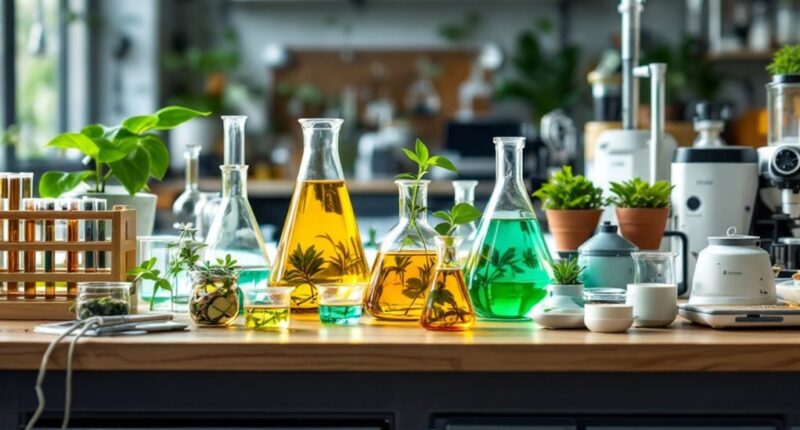Sustainable chemistry replaces harmful substances with green alternatives that maintain effectiveness while reducing environmental impact. Instead of toxic solvents, chemists now employ water or benign alternatives. “Benign by design” principles create safer cleaning supplies and cosmetics, while catalysts enhance reaction efficiency without energy-intensive processes. These innovations protect worker safety, improve consumer health, and demonstrate that environmental responsibility doesn’t sacrifice performance. The chemical industry’s transformation proves that being green isn’t just responsible—it’s remarkably practical.

While our modern world depends on chemical innovations for everything from smartphones to medicines, sustainable chemistry principles offer a revolutionary framework for creating these essentials without compromising our planet’s future. Think of it as chemistry’s redemption arc – transforming from an environmental villain into an ecological hero, one molecule at a time. This holistic approach extends beyond green chemistry’s borders, considering not just environmental impacts but also social and economic factors throughout a product’s entire lifecycle.
At its core, sustainable chemistry operates on elegantly simple logic: prevent waste rather than clean it up later (because chemical messes are like toothpaste – nearly impossible to put back in the tube). Maximizing atom economy – using almost every atom in your starting materials – is like making sure every bit of cookie dough becomes an actual cookie, with no scraps wasted. The principles extend to designing safer chemicals that are “benign by design” – molecules engineered from the ground up to play nicely with humans and ecosystems alike. From cleaning products to cosmetics, manufacturers are increasingly adopting safer ingredients that minimize health risks while maintaining effectiveness.
Industrial chemists are reimagining production processes through this sustainable lens, swapping energy-hungry reactions for ambient conditions and replacing toxic solvents with water or other benign alternatives. Catalysts – chemistry’s equivalent of reusable shopping bags – enable reactions to occur with minimal energy and maximum efficiency. The field particularly emphasizes biocatalytic processes that utilize enzymes under mild conditions with exceptional selectivity. Real-time monitoring systems act like smoke detectors, catching potential pollution before it happens. The development of green solvents derived from renewable resources exemplifies this shift toward more environmentally responsible chemical processes.
The benefits ripple beyond environmental protection to include worker safety, consumer health, and economic viability. By designing products that safely degrade when their useful life ends, sustainable chemistry closes the loop on material flows. Sustainability scorecards and metrics like E-factor (measuring waste per product) provide concrete ways to measure progress.
Perhaps most importantly, sustainable chemistry represents a philosophical shift – acknowledging that chemical innovation must balance present needs with future responsibility. Through cross-sector collaboration and systems thinking, these principles are transforming how we create everything from pharmaceuticals to plastics, proving that protection and progress can coexist brilliantly in laboratory flasks worldwide.
Frequently Asked Questions
How Much Do Green Chemistry Alternatives Typically Cost?
Green chemistry alternatives typically cost 75-85% more than conventional products, though pricing varies widely by category.
While sustainable household cleaners cost just a few cents more, organic cotton and sustainable wood products command considerably higher prices.
This cost differential stems from expensive raw materials, specialized manufacturing processes, and investments in new technology.
Notably, higher initial costs are often offset by long-term savings through reduced energy consumption and waste management expenses.
Which Industries Have Adopted Sustainable Chemistry Most Successfully?
The pharmaceutical industry has emerged as a leader in sustainable chemistry adoption, with companies like Pfizer and Merck implementing significant process improvements.
Chemical manufacturing follows closely, with innovations from Dow and BASF demonstrating impressive environmental gains.
Consumer goods companies like P&G and Method Products have successfully incorporated green chemistry principles into everyday products.
Electronics manufacturers have also made strides, with Apple and Intel reducing harmful substances and emissions in their manufacturing processes.
Are Green Chemistry Products as Effective as Traditional Ones?
Evidence shows green chemistry products often match or exceed traditional alternatives in effectiveness.
Soy-based inks provide more vibrant colors than petroleum counterparts, while enzyme-based detergents clean efficiently at lower temperatures.
Bio-based solvents demonstrate comparable dissolving power to conventional options.
Some challenges remain, including scaling up production and addressing shelf-life issues, but continuous research is closing performance gaps.
Industries increasingly adopt these alternatives as they prove both environmentally friendly and functionally competitive.
What Barriers Prevent Wider Implementation of Sustainable Chemistry?
Wider implementation of sustainable chemistry faces multiple roadblocks across different sectors.
Economically, high development costs and entrenched supply chains favor conventional methods. Regulatory frameworks lack clear definitions and incentives for green alternatives.
Technical challenges include scaling laboratory processes to industrial levels and designing molecules that balance effectiveness with safety.
Meanwhile, organizational resistance to change and siloed research approaches further impede progress.
These interwoven barriers create a complex landscape that slows the shift despite proven benefits of sustainable chemistry practices.
How Can Consumers Identify Products Made With Sustainable Chemistry?
Consumers can identify sustainable chemistry products by looking for eco-labels like Green Seal, EPA Safer Choice, and Cradle to Cradle certifications.
Scrutinizing ingredient lists helps avoid harmful chemicals while supporting transparency.
Digital tools such as EWG’s Skin Deep database and the Think Dirty app offer on-the-go product screening.
Additionally, supporting B Corps and companies participating in the Chemical Footprint Project directs dollars toward businesses genuinely committed to greener chemistry practices.









